Updated January 2024.
Facebook advertising holds the power to transform mere leads into loyal customers, but diving into its vast ocean without a map can be both intimidating and costly. That’s why Facebook Ads ecommerce case studies can serve as a shortcut to crafting a masterful strategy without the trial and error.
Case studies are not just tales of success, but blueprints for achieving remarkable ROAS.
In this post, we’ll unveil four standout e-commerce Facebook Ads campaigns. These stories will not only inspire you, but will also guide you on how to captivate your target audience, skyrocket B2C sales, and optimize your ad spend.
TABLE OF CONTENTS:
Single Grain’s Facebook Ads E-commerce Case Study with 3X ROAS
ThinSlim Foods is a brand of low-carb products that has been doing quite well: They’ve grown 100-150% every year for the last seven years.
When Single Grain started working with them, Thin Slim was a healthy account doing around $70K-$80K a month across all accounts on paid advertising spend. And although they were getting a good ROAS, there was a problem. TSF came to us and said:
We need a better strategy to scale conversions while maintaining a healthy ROAS.
TSF had been unable to scale paid social and search performance to get more conversion volume while maintaining a performance goal of 3x ROAS.
We were able to increase spend by 2.5X and scale sales by 1.7X while maintaining our 3X ROAS performance goal:
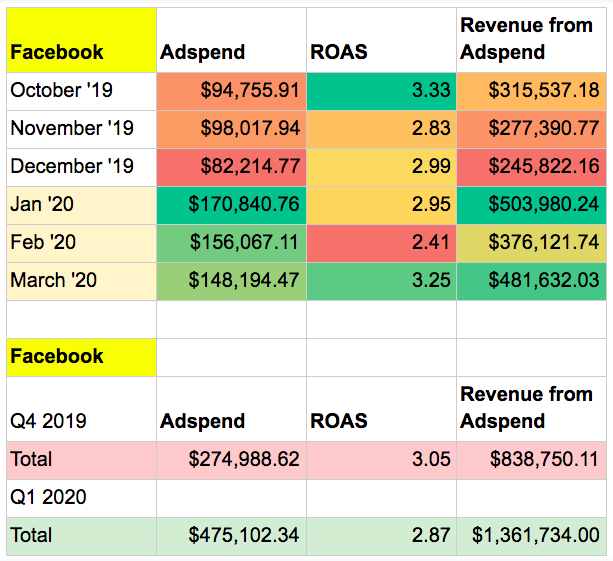
Check out this post, where we show you the biggest strategic shifts that doubled conversions — so you can use them for your brand, too!
👉 Ecommerce Advertising Strategy: How We Doubled PPC Sales for ThinSlim Foods (with a 3X+ ROAS) 👈
For CEO Eric Siu, the pursuit of innovation is relentless. He and the whole SG team are continually exploring new frontiers in technology, paid ads and other marketing strategies to ensure that what works wonders for us also delivers exceptional results for our clients.
Here’s why machine learning sucks for predicting ad success. Just because large ad platforms have rich datasets doesn’t mean they’re able to forecast the future well.
This study was done by Meta and Northwestern University and it just goes to show that at the end of the day, the… pic.twitter.com/dlWajxifsc
— ericosiu (@ericosiu) January 24, 2024
Single Grain enables us to increase our impact without increasing our headcount
👆 Just want someone to do the work for you? Single Grain’s Facebook Ads experts can help!👆
4 Facebook Ads E-commerce Case Studies that Increased ROAS
Now, let’s look at four Facebook Ads e-commerce case studies to see how they increased ROAS.
1) SkeletonHD
One of the best aspects of owning an online store is that sellers can target a niche audience and still convert leads and increase sales.
SkeletonHD creates a specific product for a niche audience: skull jewelry for men. All their pieces are authentic and unique, ones you can’t find anywhere else. From bracelets with skull beads to chains with skull pendants, SkeletonHD offers high-quality jewelry for men who have an alternative edge.
However, SkeletonHD struggled to achieve an ROI on its Facebook Ad campaign.
The Challenge: Making an ROI on Rising Facebook Ad Costs
No, you’re not imagining things – Facebook Ads are getting more expensive. With the average CPC as high as $0.97, this is a hindrance for many small e-commerce businesses, such as SkeletonHD. Specifically, SkeletonHD was struggling with the rising costs in customer acquisition and CPMs (cost per mille, also known as cost per thousand).
Though most competitors are investing less in Facebook campaigns and putting advertising dollars toward other platforms, SkeletonHD’s owner Samer Biladi decided to invest heavily in a Facebook Ads strategy before costs increased even more.
Unfortunately, his efforts weren’t successful. His customer acquisition decreased by 30%. He was able to attract more prospects but wasn’t to convert them into sales.
Strategy: Automation
Although SkeletonHD didn’t hire Single Grain, they did follow our advice from our post about critical Facebook Ads trends and then contacted us afterwards to let us know about their success.
The problem was that SkeletonHD’s Facebook advertising strategy lacked management. They were using all of Facebook’s advertising mediums, but were using the same ad for all. This wasn’t helping with audience targeting, and they were only targeting the same Facebook users.
However, all this implementation and testing was taking a toll on Samer’s time and resources. This is why Samer followed our advice and worked on an automation advertising strategy for Facebook.
The strategy consisted of multiple tactics:
- Campaign budget optimization
- Automatic placements
- Automatic language translation
- Dynamic formats
- Multiple text optimization
With these tactics, Facebook’s automation tools helped Samer stay on budget, place ads over various Facebook and Meta products, make his ads available to a global audience, generate high-performing ads, and add different text versions for the same ad.
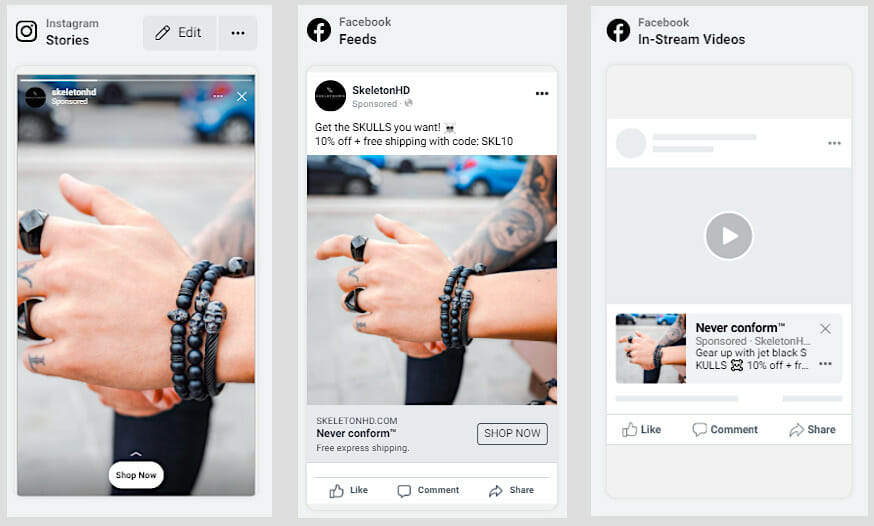
SkeletonHD’s strategy also emphasized certain aspects, such as placing ads on stories, optimizing ads for mobile and using more video content.
Results: Increased Facebook Reach by 5X
Even though SkeletonHD increased its ad spend by 300%, they also:
- Increased their Facebook reach by 5X
- Improved their CPM by 15%
- Increased conversions by 7%
- Improved engagement by 19%
Because of these results, SkeletonHD doubled their overall business revenue.
Dive Deeper: How This E-commerce Store Doubled Its Revenue Using Our Facebook Ads Advice
2) Seltzer Goods
Another top Facebook ads ecommerce case study is of Seltzer Goods. It is a woman-owned company that makes modern goods for the home. Unlike competitors, Seltzer Goods creates products that are creative and can inspire laughter and even curiosity in the onlooker.
Seltzer Goods was on its way to the top when the pandemic hit. As with many businesses, their sales dropped. To generate leads and nurture them down the sales funnel, Seltzer Goods decided to increase their ad spend.
The Challenge: Increase B2C Sales During the Pandemic
Seltzer Goods has two main audiences: B2B wholesalers and direct-to-consumer sales. During the pandemic, their B2B wholesale sales were decreasing. To offset the damage, Seltzer Goods focused on their B2C market, tapping into the e-commerce lockdown demand that many online businesses were experiencing.
Seltzer Goods also had a unique advantage over competitors – they sell many fun activities that can be enjoyed at home. For example, Seltzer Goods sells many unique puzzles and game books that keep customers busy:
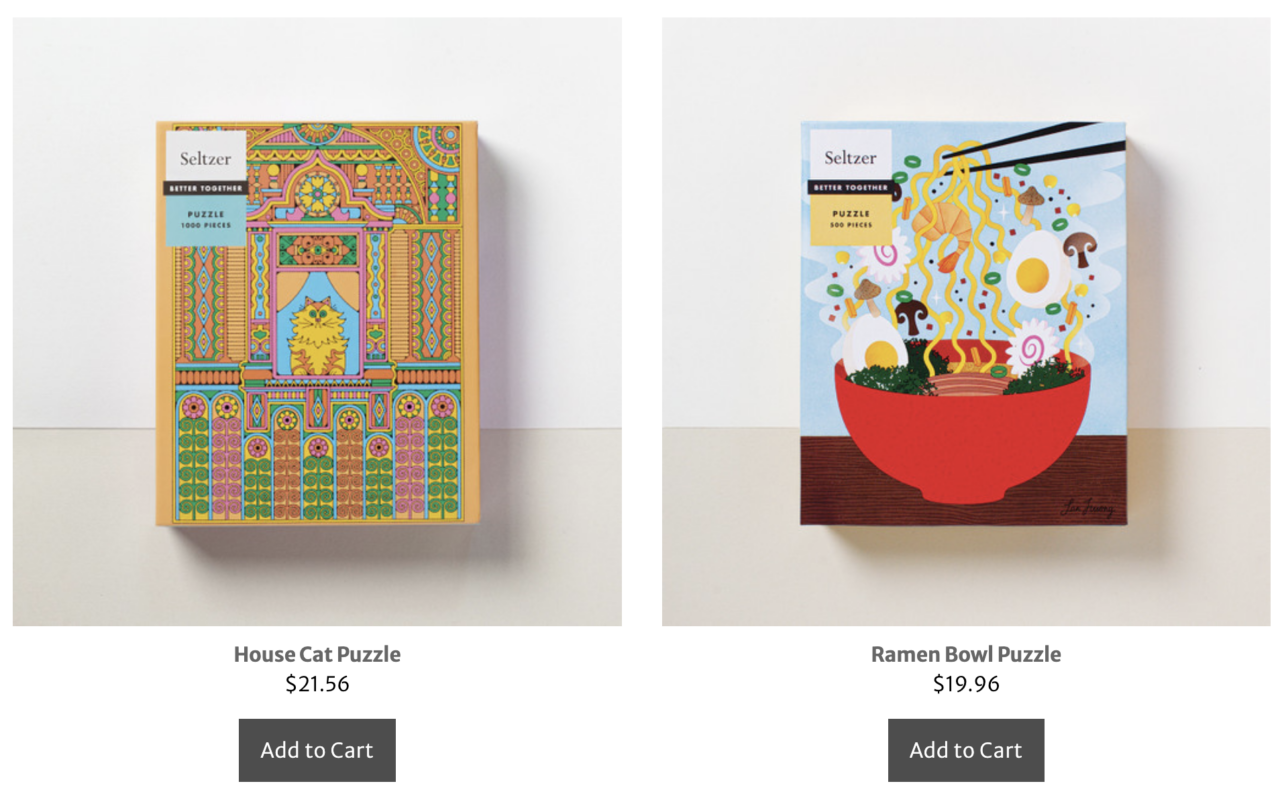
There was one main problem – Seltzer Goods didn’t have enough awareness in the B2C market. This is when they decided to invest in an advertising strategy on Facebook and Instagram. The main components of their strategy were to write creative ad copy, scale their budget and target a cold audience.
Strategy: Create a Strategy from Scratch
Even though Seltzer Goods knew they needed a social media advertising campaign, they had never created one. So they contacted an advertising company to create an entire strategy from scratch.
The first thing the ad company did was add Facebook Pixel to the company’s website to collect data on website traffic and customers. This data showed that Seltzer Good’s audience was more active on Facebook and Instagram, where most of the advertising strategy would occur.
Since Seltzer Goods wanted to target a cold audience, the ad company implemented a See, Think and Do sales funnel:
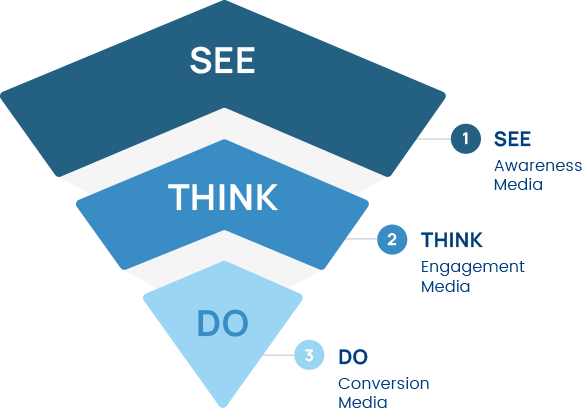
This funnel first raises awareness, then entices engagement in the second stage, leading to conversions at the final stage. This strategy included no retargeting ads.
Seltzer Goods used Facebook audience insights to target qualified shoppers while saving time and money. They kept their ad creation and management simple, largely using automation to place ads. The products they targeted included activities, specifically puzzles, that users could do while staying at home.
They kept their ad spend low and used a one-day click delivery optimization, shortening the buying cycle even more. The ad company tested a few ads, running two different ad creatives against the same ad copy simultaneously to see which led to more conversions:
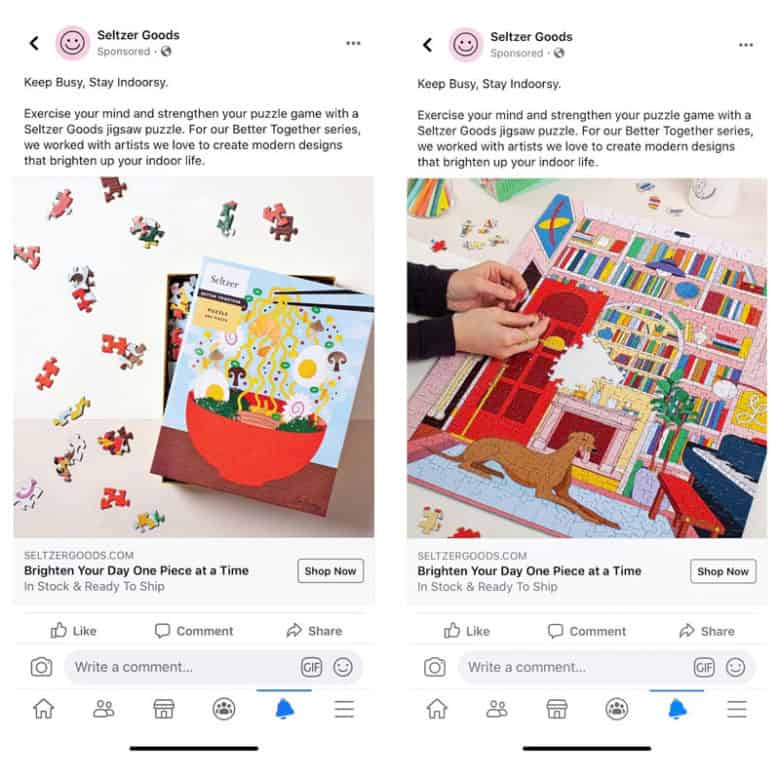
The copy stayed on brand: it was positive, relevant to the product, and offered a message of togetherness in an unpredictable time.
The ad company identified three types of audiences:
- Add to Cart users
- Key page visitors
- Purchasers
This expedited the data collection process, identifying who was more likely to view the website versus those who purchase products.
Results: Increased Monthly Revenue and ROAS
Even though Seltzer Goods had to create a Facebook advertising strategy from scratch, their efforts resulted in a 25% monthly revenue increase and a 4.5X ROAS.

They also achieved a 785% increase in monthly revenue, a 319% increase in clicks, a 105% increase in total brand impressions, and a 105% CTR increase.
During the campaign, Facebook and Instagram accounted for 25% of Seltzer Goods’ sales. They achieved all of this while spending less than $10 per CPA.
3) Market Square Jewelers
Another leading Facebook ads case study is of Market Square Jewelers. This is a multi-million dollar company that sells estate and antique jewelry. They have a brick-and-mortar store in Cambridge, Massachusetts, and a successful e-commerce store. But when they first launched their online store, they had little brand awareness outside their physical location and were experiencing heavy competition.
Market Square Jewelers knew that running Facebook Ads was the best strategy, but they also knew they would need help.
The Challenge: Raise Brand Awareness
Since they were facing heavy competition, Market Square Jewelers knew the first step was to raise brand awareness, and the quickest way to achieve this was by investing in an advertising campaign.
Market Square Jewelers turned to an advertising expert who got them started on a Facebook advertising strategy.
Strategy: Target Female Buyers
To save time and costs, they focused on promoting their most popular product – their estate and antique engagement rings:
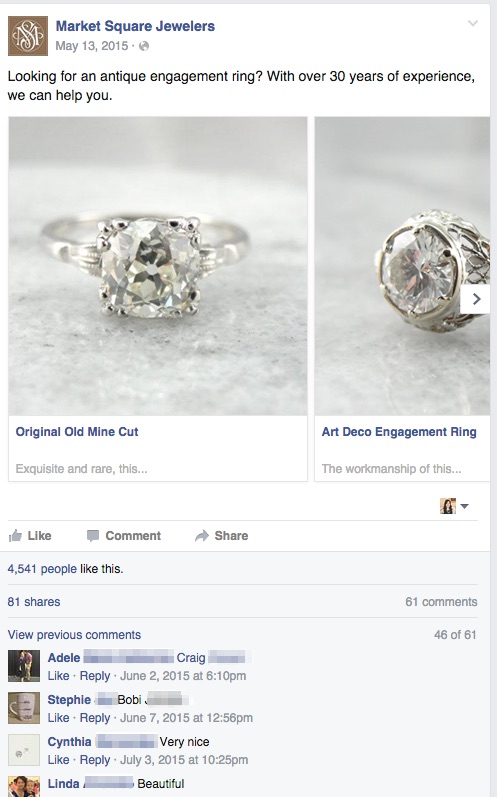
Market Square Jewelers realized they had an advantage over the competition: Since they offered unique and niche engagement rings, they would attract more female attention. This is different from other jewelers, who target men in the hunt for the perfect engagement ring.
The ad expert helped Market Square Jewelers create carousel ads using high-quality images of the engagement rings. Even though Market Square Jewelers was new to e-commerce, they had decades of experience in their local market, which they included in their ad copy. This helped the store establish credibility in the online market.
To stick to an ad budget, Market Square Jewelers consistently spent $7.50 on ads daily.
Spending a little bit over a long-term period (6-8 months) will result in consistently running ads, which will pull more leads down the sales funnel. Brands can also choose to spend more or less with this method; Market Square Jewelers spent more during the first part of their campaign and decreased their spending over time.
Results: Increased Reach
Market Square Jewelers targeted more female researchers in their engagement ring ads, and the results paid off big time. The biggest success was that the brand gained a total reach of 277,580. But these aren’t the only figures the brand achieved.
From their advertising campaign, Market Square Jewelers saw these results:
- 25,653 clicks
- 478,928 impressions
- 5.36% click-through rate
- 40% sales increase
- 1,631.63% increase in Facebook
Market Square Jewelers achieved these results with a $0.06 cost-per-click and only spending $1,495.88 over the course of six months.
Need help creating stunning ads that convert? Single Grain’s Facebook Ads experts can help!👇
4) Sand Cloud
Spending a day relaxing on the beach sounds like a dream. But by the end of the day, sand is everywhere. Everywhere! All over your clothes, belongings and even your towel. Even after shaking off your towel, there are still traces of sand that get all over your car and home.
Sand Cloud found a solution for this common annoyance. They created a unique line of sand-free beach towels made of high-quality Turkish cotton in unique designs. The company also supports marine life, and 10% of its profits go toward marine conservation.
Even though they were already successful, they wanted to use Facebook’s creative advertising tools to generate more sales.
The Challenge: Attract the Parent Demographic
Sand Cloud is a young company that opened in 2014. They mainly attracted the 18-24 consumer base and wanted to increase sales among the older demographic, specifically parents. This would not only increase sales, but improve their current advertising campaign.
They always used a creative ad strategy to draw the attention of the younger crowd so they decided to use these same tactics to draw attention from parents.
Strategy: Feature Families in Their Ads
Sand Cloud’s previous advertising efforts didn’t feature families – their ads featured young people on a luxurious beach vacation. To drive more sales from parents, they included more family-friendly media and ad copy:
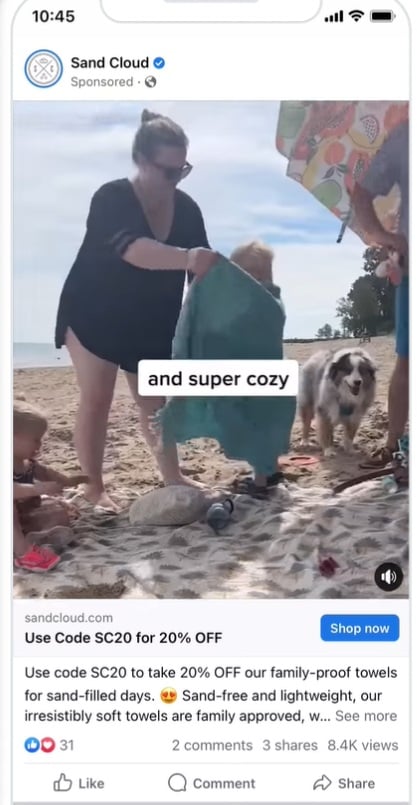
They started with a video ad featuring parents with two young children and a dog. The video showed the family having fun on the beach, using Sand Cloud’s beach towels. The parents dried off the kids and dog with the Sand Cloud towels. There was even footage of the kids cuddling up with the sand-free towels in the car.
They included their ad copy directly in the video as text overlays. The messaging was positive and built trust, such as “100% organic.” The ad included a “Shop Now” button that directed viewers to the company’s website.
In addition, they used A/B testing to compare the performance of the new ads with their previous ones.
Results: 30% Increase in Reach
Sand Cloud achieved an impressive 30% in new customer reach when using the new ads compared to the previous ones. Attracting a slightly broader audience still resulted in a 24% lower cost per purchase.
Dive Deeper: How to Run A/B Tests that Actually Increase Conversions
The Power of Facebook Ads in E-commerce
If you own an e-commerce business, it’s easy to think you should put your advertising dollars in ad accounts such as Google or Amazon rather than Facebook. After all, the young generation isn’t on Facebook anymore, right?
In reality, 426.8 million people in the 18-24 age group and 596.8 million people in the 25-34 age group use Facebook, making up a large chunk of the Gen Z and Millennial demographics:

In 2022, Facebook’s ad revenue was worth $113 billion and it is still predicted to be a powerful advertising platform in 2023 and the future.
This is why more e-commerce companies have been investing in ads on Facebook.
Let’s take a deeper look at the top advantages of Facebook ads in e-commerce:
- Extensive User Base: With more than 2.93 billion users, Facebook boasts one of the largest user bases globally, making it an excellent platform for reaching a broad and global audience.
- Advanced Targeting: Facebook offers robust targeting options, allowing advertisers to hone in on specific demographics, interests, behaviors and even life events.
- Custom Audience: Advertisers can create custom audiences by uploading customer lists or website visitor data, enabling them to target previous customers and website visitors.
- Lookalike Audiences: Facebook’s lookalike audience feature is powerful for expanding reach by targeting the right audience that is similar to your existing customers.
- Ad Formats: Facebook offers a diverse range of ad formats, including image and video ads, carousel ads, collection ads, instant experiences, and more:
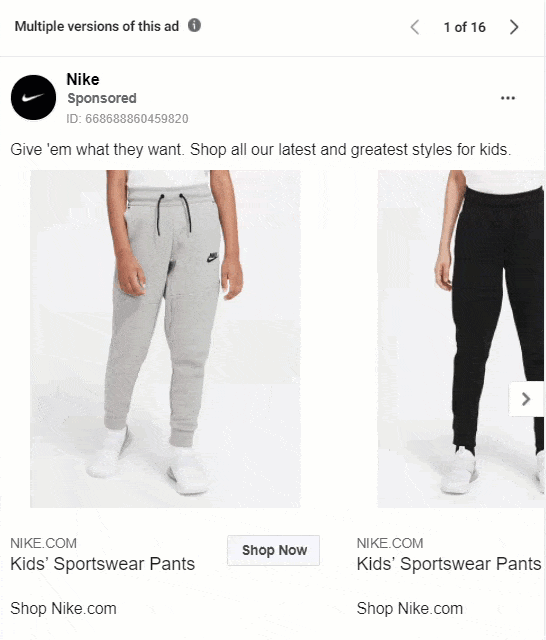
- Dynamic Ads: Facebook’s dynamic ads automatically promote relevant products to users based on their browsing behavior, making them highly effective for e-commerce.
- Conversion Tracking: Facebook provides robust conversion tracking tools, enabling advertisers to measure the ROI of their campaigns accurately.
- Budget Flexibility: Advertisers can set flexible budgets on Facebook, making lead generation accessible for businesses with varying financial resources.
- Mobile Optimization: Facebook is well-optimized for mobile users, which is crucial as mobile usage continues to rise.
- Ad Creativity: Facebook allows for creative storytelling through various ad formats, enabling brands to engage users effectively.
Tips for Achieving the Best ROAS from Facebook Ads
Before diving into the four case studies, take a look at these tips to get the most out of your Facebook Ads so you can be even more prepared to get inspiration from the case studies below:
✅ Define clear campaign objectives: Start with a well-defined goal for your campaign, whether it’s attracting quality traffic, generating leads or driving e-commerce sales. Having clear objectives helps you tailor your strategy accordingly.
✅ Use high-quality visuals and compelling ad copy: Visual elements and ad copy are crucial for grabbing users’ attention. Use eye-catching visuals like this Macy’s ad and persuasive copy that resonate with your target market:
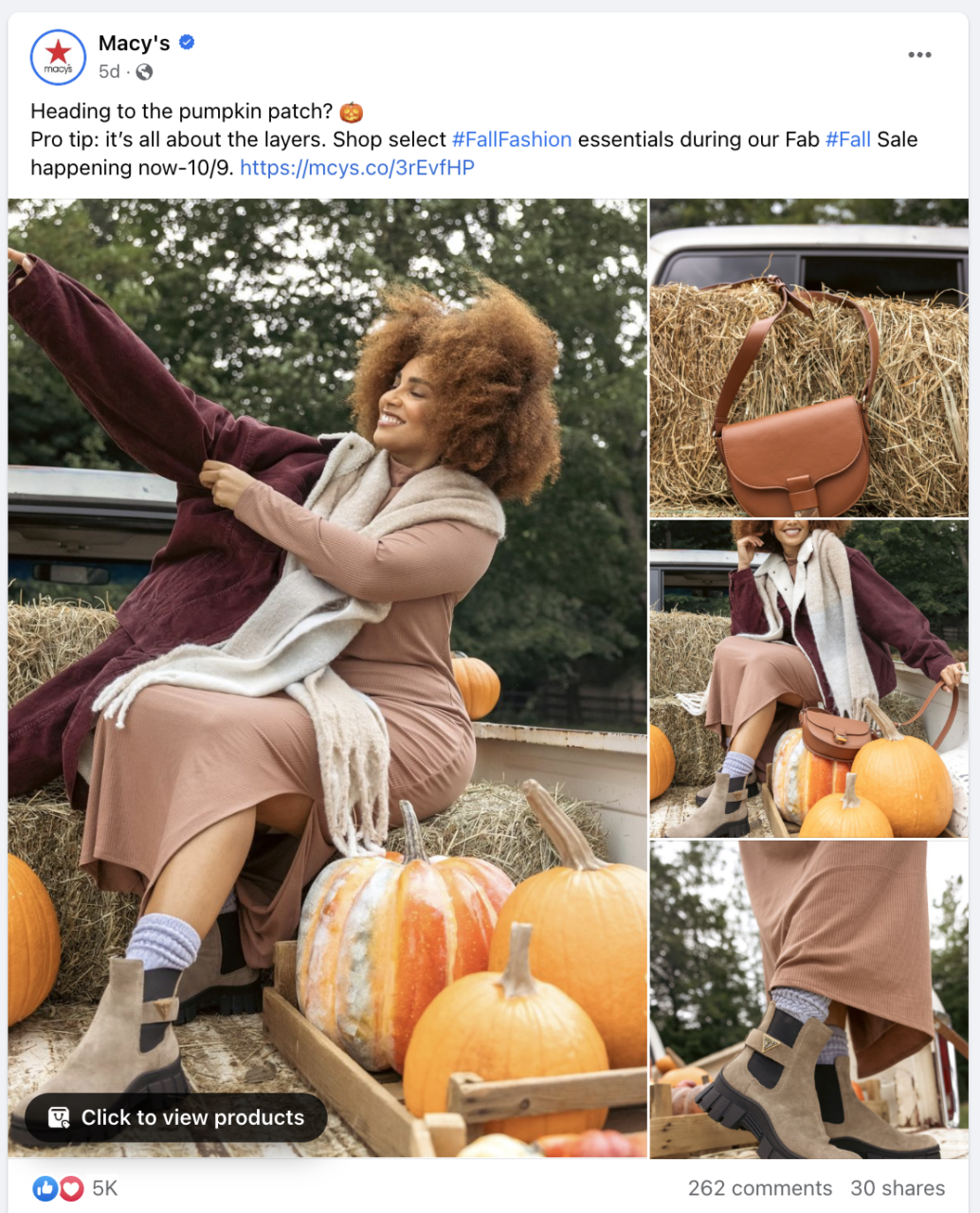
✅ Segment and target your audience precisely: Effective targeting ensures that your ads reach the right people. Segment your audience based on demographics, interests and behavior to maximize relevance.
✅ Implement retargeting campaigns: Retargeting users who have previously interacted with your website or app increases the likelihood of conversions by reminding them of your products or services that they’ve already shown an interest in.
✅ Test different ad formats: Experiment with various ad formats, such as carousels, videos and slideshows, to see which resonates best with your audience and objectives.
✅ Optimize landing pages for conversions: Make sure the pages that users land on after clicking your ads are optimized for conversions, with clear calls to action and valuable content.
✅ Set up Facebook Pixel for tracking and optimization: Facebook Pixel is essential for tracking user actions on your website and optimizing ad campaigns for conversions and ROI.
✅ A/B test ad creatives and copy: Continuously test different ad creatives and copy variations according to Facebook’s algorithm and relevance score. Identify which elements perform best and refine your campaigns accordingly.
✅ Monitor and adjust ad placements: Keep an eye on ad placements to ensure your ads are appearing where they perform best and adjust as needed.
✅ Use lookalike audiences: Create lookalike audiences based on your existing customer data to expand your reach to users who share similarities with your current customers.
✅ Optimize for mobile users: Given the prevalence of mobile users, make sure your ads and landing pages are mobile-friendly for a seamless experience:

✅ Schedule ads for peak engagement times: Time your ads to appear when your target audience is most active on the platform to maximize visibility and engagement.
✅ Adjust bids based on performance: Continuously monitor ad performance and adjust bidding strategies to achieve desired results while managing costs effectively.
✅ Monitor frequency to avoid ad fatigue: Keep an eye on ad frequency to prevent overexposure of an ad set to the same audience, which can lead to ad fatigue and decreased effectiveness.
✅ Use dynamic ads for e-commerce: Dynamic ads automatically display relevant products to users who have expressed interest, enhancing the personalization of your e-commerce campaigns.
✅ Implement automated rules for bid adjustments: Streamline campaign management by setting up automated rules to adjust bids, budgets and other parameters based on predefined conditions.
✅ Refine audience targeting with custom and saved audiences: Leverage custom and saved audiences to refine your ad targeting and reach specific segments of your audience with tailored messages.
✅ Analyze ad metrics regularly and adjust strategy accordingly: Regularly review ad performance metrics, such as click-through rates and conversion rates, and make data-driven adjustments to your strategy. You can use Google Analytics and other Facebook Ad tracking tools for this purpose.
✅ Incorporate user-generated content: Encourage your audience to create content related to your products or services, fostering authenticity and engagement.
✅ Leverage video content for higher engagement: Video campaign often generates higher engagement rates, so incorporate it into your ad strategy when relevant.
✅ Use Facebook’s Campaign Budget Optimization (CBO): CBO automatically distributes your budget across ad sets to optimize campaign performance based on your objectives.
✅ Stay updated with Facebook’s ad policies and best practices: Keep current with Facebook’s guidelines and best practices to ensure compliance and maximize the effectiveness of your campaigns.
✅ Collaborate with influencers or brand ambassadors: Partner with influencers or brand ambassadors to leverage their reach and credibility to promote your products or services.
✅ Encourage user reviews and testimonials: Positive user reviews and testimonials can boost trust and credibility, so encourage satisfied customers to share their experiences.
✅ Continuously learn about recent Facebook Ads updates and new features: Stay informed about Facebook’s evolving features and updates by investing in ongoing education and training to stay competitive in the ever-changing digital landscape.
Use a Facebook Ads E-commerce Case Study to Influence Your Campaign
Facebook Ads are still a core part of any e-commerce company’s advertising strategy. But creating a successful campaign can be difficult since Facebook’s advertising costs are increasing.
The social media giants also offer many advertising tools and products, so it can be difficult to know which strategies will work for your ad campaigns. Store owners can get inspired by a Facebook ads e-commerce case study to see which tactics worked for other sellers, and try to replicate their own successful advertising strategy.
Hopefully you learned how to improve your Facebook Ads, but if you don’t have the bandwidth, Single Grain’s Facebook Ads experts can help!👇
Facebook Ads FAQs
-
What are some best practices for creating effective e-commerce Facebook Ads?
Best practices include using high-quality visuals, crafting compelling ad copy, split testing ad variations, optimizing landing pages, and setting clear objectives for your campaigns.
-
Are there any budgeting tips for e-commerce Facebook Ads?
Start with a budget you’re comfortable with, and adjust as you monitor performance. Consider using Facebook’s Campaign Budget Optimization (CBO) to distribute your budget effectively across ad sets.
-
How can I keep up with changes in Facebook Ads policies and features?
Stay informed by regularly checking Meta advertising standards and following updates on the Facebook for Business blog. Joining Facebook Ads-related communities and attending webinars can also help.


